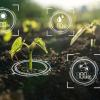
IIASA researchers are collaborating on a new Horizon Europe project, which will use artificial intelligence to help farmers and land managers analyze their soil health without the need for a laboratory.
The AI4SoilHealth project aims to create a digital platform using artificial intelligence (AI) to provide a comprehensive assessment of soil health across Europe and support the European Commission’s objective of transitioning towards healthy soils by 2030.
Today, it is estimated that between 60 and 70% of the EU’s soils are unhealthy. Healthy soils capture carbon, improve yields, help reduce flooding, and boosts biodiversity, but they are under pressure from current farming practices and the increasing demand for food. To reverse this trend, we need to understand which farming practices work and which do not to restore soil health. The climate crisis leaves little room for mistakes as soil is complex and we need to map changes into the future so we can make and implement the right strategies in the right places. To do this, land managers and policymakers have to be equipped with the appropriate tools to give them the confidence to make the required changes to their farming practices to improve soil health and resilience.
"We are at a crossroads. We need to do something if we are to preserve European and global soil resources. It is a paradox that on the one hand soil is part of the solution to reduce greenhouse gas emissions, and at the same time 60-70% of Europe's soil is not doing well. It is therefore imperative that we have better monitoring of soil quality,” explains Mogens H. Greve from the Department of Agroecology at Aarhus University, who coordinates the AI4SoilHealth project.
The project will provide an effective soil health index certification system to support landowners and policymakers under the European Green Deal and a free app developed as part of the project, will help farmers and growers make changes in their farming practices.
Researchers from the Agriculture, Forestry, and Ecosystem Services (AFE) Research Group of the IIASA Biodiversity and Natural Resources Program will contribute expertise to the project by providing pan-European predictions of future soil organic carbon status and dynamics in response to climate change, taking into account crop varieties, soil management, and land use interventions. They will use the IIASA Environmental Policy Integrated Climate-based Global Gridded Crop Model (EPIC-IIASA) to simulate complex relationships in the system. The future soil health indicators resulting from the IIASA team’s modeling efforts, will be approximated for end-users by AI-based solutions and will eventually feed into a European Soil Health Data Cube – a data service for a variety of stakeholders operated in close collaboration with the European Commission’s Joint Research Center.
“Being part of this project is a great opportunity for the EPIC-IIASA team to get involved in the European Union’s plans for transitioning towards healthy soils by 2030. It is also a chance for us to put our existing knowledge on crop systems into practice in a novel way, including the application of advanced data and statistical modeling with AI-based tools,” notes Rastislav Skalsky, a researcher in the AFE Research Group at IIASA.
The project will create and maintain an open access Europe-wide digital infrastructure, compiled using state-of-the-art AI methods combined with new and deep soil health understanding and measures. Over the next three years, the 28 partners spanning 11 EU countries will collect data from farms and pilot sites across Europe to build a model to work from. Along the way they will share their learnings, educating people about the latest soil health measurement techniques and sharing stories from the soil practitioner community.
AI4SOILHealth demands a multi-layered approach with seven key work-streams including policy and stakeholder engagement, development of soil health methodology and standards, developing field and laboratory solutions for observations and measurement, and harmonization across EU-wide soil monitoring services. It will also utilize pilot models in several countries running field trials to establish user testing and feedback, and building communication tools to develop campaign and educational to promote awareness and adoption.
Horizon Europe is the EU’s key funding program for research and innovation with a budget of €95.5 billion. It tackles climate change, helps to achieve the UN’s Sustainable Development Goals, and boosts the EU’s competitiveness and growth by funding different types of collaborative projects. AI4SOILHealth is one of Horizon’s key Research and Innovation Action (RIA) projects which seeks to fund the establishment of new knowledge, and explore new or improved technology and solutions.
Further info:
Visit the official project website at https://ai4soilhealth.eu/
News

03 February 2025
Dr. h.c. Johan Kuylenstierna receives prestigious H.M. The King's Medal

17 January 2025
IICA explores research opportunities with IIASA

05 December 2024

